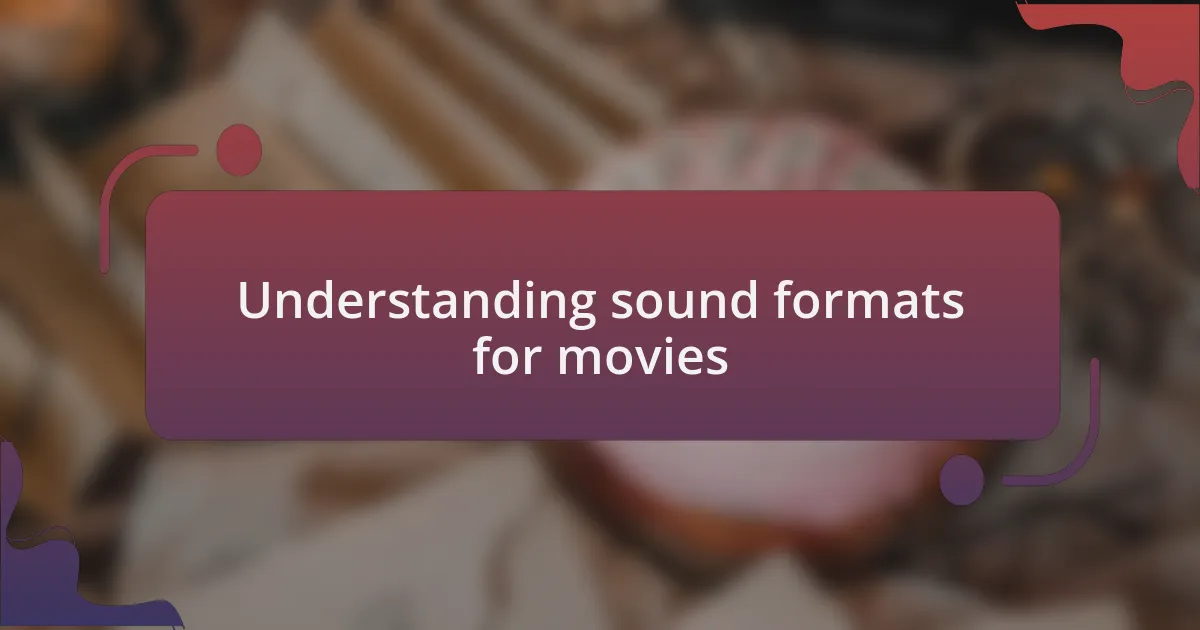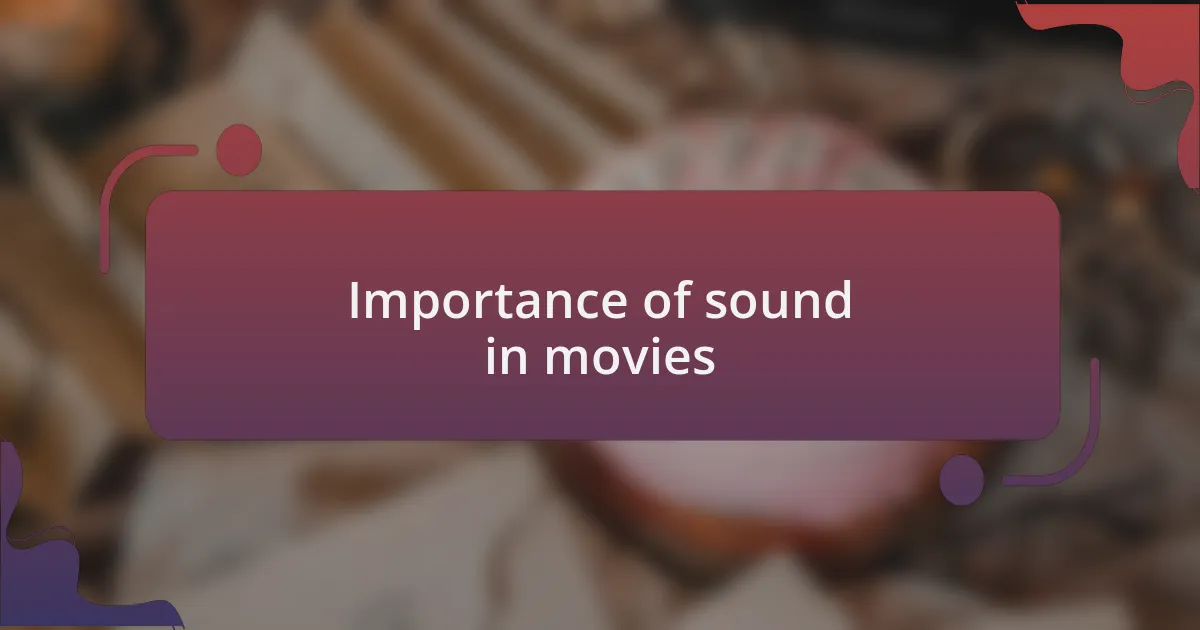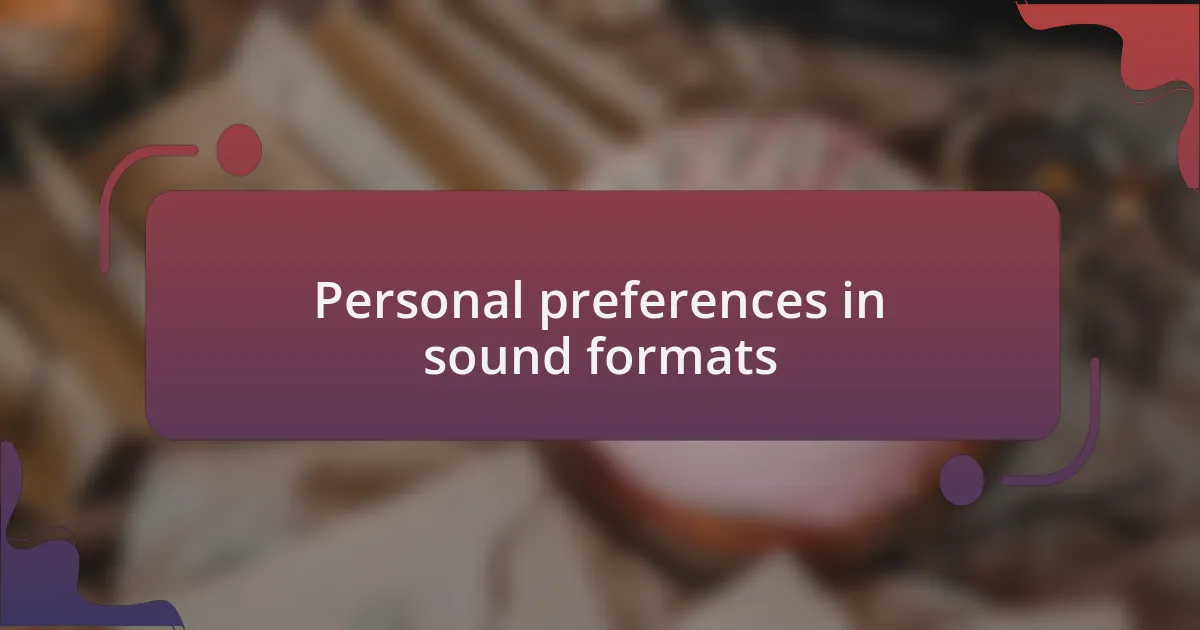Key takeaways:
- Sound formats like Dolby Atmos and DTS-HD Master Audio significantly enhance the movie-watching experience through immersive audio and clarity.
- Sound is a vital storytelling element, influencing emotions and nostalgia, as shown by impactful soundtracks and detailed sound design.
- Blu-ray players revolutionize home entertainment by providing high-definition audio and video, along with streaming capabilities.
- Personal preferences in sound formats vary based on film type, with a focus on clarity, immersion, and balanced dynamics for an optimal viewing experience.

Understanding sound formats for movies
Sound formats in movies play a crucial role in shaping the overall viewing experience. When I first encountered Dolby Atmos, I was taken aback by its immersive soundscapes. It made me feel like I was right in the middle of the action—almost like I could hear the raindrops falling around me, which added a level of realism I had never experienced before.
There’s also something special about lossless formats like DTS-HD Master Audio. I remember watching a classic film that I had seen multiple times, but this time, the clarity of the dialogue and the richness of the soundtrack were astonishing. It was as if I had discovered new layers to the story just by upgrading my sound setup. Isn’t it fascinating how the little details in sound can transform familiar scenes into something new?
Understanding sound formats can be overwhelming, but I find that focusing on how they enhance my experience makes it easier. I often ask myself, “What emotions do I want to feel while watching this film?” The answer guides my choice of sound format, ensuring that each viewing is not just entertainment but a full sensory journey.

Importance of sound in movies
Sound is an integral element of storytelling in films. I recall the first time I watched a thriller with a surround sound setup; every creak and whisper seemed to linger in the air, pulling me deeper into the narrative. The tension heightened with each sound effect, proving that audio not only supports the visuals but also drives the emotional core of the story.
When I think about epic soundtracks, I’m reminded of how they can elevate a scene from good to unforgettable. Recently, I rewatched a beloved fantasy film, and the orchestral score transported me right back to my childhood. The music swelled at just the right moments, stirring up nostalgia and making me feel a connection to the characters in ways I hadn’t appreciated before. Isn’t it remarkable how sound can trigger such powerful memories?
Moreover, the impact of sound design can sometimes be overlooked in discussions about filmmaking. For instance, I remember a documentary that used subtle ambient sounds to immerse viewers in its setting. It struck me how these layers of sound created an atmosphere that visuals alone couldn’t achieve. This goes to show that sound is not just an accessory but a fundamental part of how we experience storytelling on screen.

Overview of Blu-ray players
Blu-ray players represent a significant leap in home entertainment technology. When I first got my hands on one, the clarity and richness of the audio and video were truly eye-opening. It felt like I was transported to the cinema — the immersive experience was unlike anything I’d encountered before.
These devices are designed to play high-definition video formats and offer various audio channels, including Dolby TrueHD and DTS-HD Master Audio. I still recall the thrill of watching my favorite action movie with a Blu-ray player, the explosions resonating all around me, making it a much more engaging experience compared to standard DVDs. Can you imagine missing out on that level of detail in sound?
Additionally, the versatility of Blu-ray players is impressive. They not only play discs but also stream content from various online services. I remember one cozy night, switching from a classic film to a new series on a streaming platform, all while relishing the idea that my Blu-ray player handled it seamlessly. It makes me wonder how I ever settled for less before.

Key sound formats supported
When it comes to sound formats, Dolby Atmos stands out significantly. I remember the first time I experienced it; the sound encircled me, making the action feel incredibly realistic. It’s like being in the center of a 360-degree audio landscape, where every sound source feels authentically placed in relation to the visuals. For me, it truly epitomizes the next level of immersion in home cinema.
Then there’s DTS:X, which also catches my attention with its object-based audio technology. This format allows for sound to move in a three-dimensional space, creating an experience that can be both thrilling and unsettling, depending on the film. One night, while watching a horror movie, the effective use of sound made my heart race — I felt as though the suspense was right beside me, amplifying every whisper and creak.
Of course, I can’t overlook the more traditional formats like Dolby Digital and DTS. While they may not offer the same surround sound precision as their newer counterparts, they still provide a solid performance for many films. I’ve often revisited classics in my collection, appreciating how even these formats can transport me back to a different era of filmmaking, reminding me of why I fell in love with movies in the first place. Which formats do you prefer, and how do they transform your viewing experiences?

Evaluating sound quality differences
Evaluating sound quality differences requires careful attention to the nuances each format offers. I recall a specific scene from an action movie where a car chase unfolded; the difference between Dolby Atmos and traditional formats was palpable. In Atmos, the roar of the engines seemed to zoom past me, while in Dolby Digital, the sound felt flatter, missing that exhilarating depth that enhances the adrenaline rush.
The subtleties in sound mixing can also dramatically influence the overall experience. When I watched a documentary on nature, the use of DTS:X was particularly striking. Birds singing above created an immersive soundscape that made me feel as if I were walking through the forest. Without that spatial accuracy, the emotional weight of the narrative would have been lost. Have you ever found yourself moved by the audio experience as much as the visuals?
Lastly, considering the impact of sound formats on dialogue clarity is essential. I often find myself turning up the volume during quieter moments in films, which can lead to unwanted surprises. In films utilizing advanced formats, every line of dialogue is crystal clear, allowing me to appreciate the storytelling without straining to catch every word. What sound format challenges have you faced in your own viewing experiences?

Personal preferences in sound formats
When it comes to personal preferences in sound formats, I find myself gravitating toward those that offer a rich, immersive experience. I remember the first time I watched a sci-fi thriller with Dolby Atmos; the environment felt alive around me. The gentle hum of distant machinery created an atmosphere that drew me deeper into the story. Don’t you think sound has a way of enhancing our connection to the narrative?
My choice in sound formats often hinges on the type of film I’m watching. For instance, I cherish the clarity that comes with lossless audio when I’m enjoying a musical film. The way the notes resonate makes the emotions conveyed through the music truly shine. Have you ever noticed how a well-rendered song can linger in your mind long after the credits roll?
Additionally, I prefer formats that ensure consistent volume levels, particularly during intense action sequences. I recall a time when I had to constantly adjust the volume while watching a high-octane film; it was more frustrating than entertaining. Formats like DTS-HD Master Audio manage to balance dynamics effectively, keeping me engaged without the hassle of fiddling with the remote. What about you—do you prioritize stability in your audio experience as well?